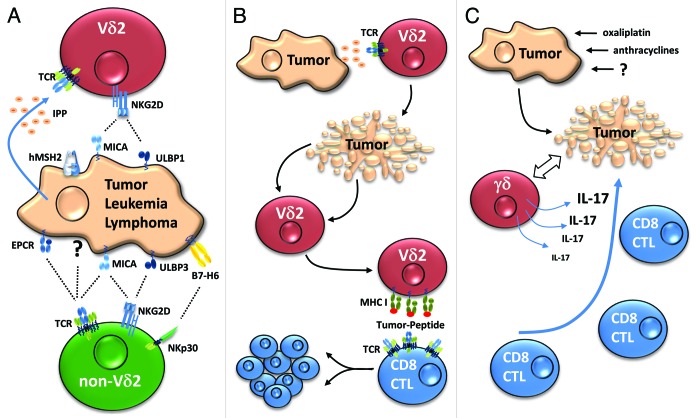Figure 1. Possible roles of γδ T cells in antitumor immunity. (A) Direct cytotoxic effector activity. The cytotoxic potential of Vδ2 T cells is activated following the T-cell receptor (TCR)-dependent recognition of tumor-associated phosphoantigens (e.g., isopentenyl pyrophosphate IPP) or ectopically expressed molecules, such as human MutS homologue 2 (hMSH2), as well as following the activation of NKG2D by MHC Class I-related chain A (MICA) or UL16-binding protein 1 (ULBP1). The specific ligands of non-Vδ2 TCRs have not been precisely identified, with the exception of MICA for Vδ1 and EPCR for Vδ5. NKG2D on Vδ1 γδ T cells is preferentially activated by ULBP3, which is often expressed on the surface of leukemia and lymphoma cells. (B) Antigen-presenting function of Vδ2 T cells. Activated Vδ2 T cells kill tumor cells (top) and can engulf antigen by phagocytosis, endocytosis or trogocytosis (middle), process such antigens and subsequently present them to tumor-specific CD8+ cytotoxic T lymphocytes (CTLs) (bottom). (C) γδ T cells contribute to effective chemotherapy. Certain chemotherapeutic agents induce immunogenic tumor cell death (top), activating interleukin-17 (IL-17)-secreting γδ T cells (middle) that are required (at least in mice) for the subsequent recruitment and activation of tumor-specific CTLs (bottom).

An official website of the United States government
Here's how you know
Official websites use .gov
A
.gov website belongs to an official
government organization in the United States.
Secure .gov websites use HTTPS
A lock (
) or https:// means you've safely
connected to the .gov website. Share sensitive
information only on official, secure websites.
